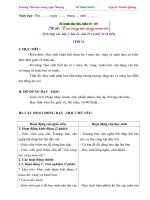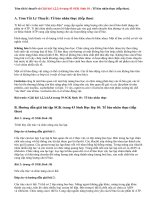CMT Chartered Market Technician Level 1
Bạn đang xem bản rút gọn của tài liệu. Xem và tải ngay bản đầy đủ của tài liệu tại đây (12.86 MB, 1,169 trang )
CMT LEVEL I
2
An Introduction to Technical Analysis
Readings Selected by
The Market Technicians Association
3
Cover design: Wiley
Copyright © 2016 by The M arket Technicians Association, except as follows:
Andrew W. Lo and Jasmina Hasanhodzic, The Evolution of Technical Analysis: Financial Prediction from Babylonian Tablets
to Bloomberg Terminals (Hoboken, New Jersey: John Wiley & Sons, 2010), Introduction, Chapters 5–8. Copyright © 2010
by Andrew W. Lo and Jasmina Hasanhodzic. Reprinted with permission.
Dr. Alexander Elder, The New Trading for a Living (Hoboken, New Jersey: John Wiley & Sons, 2014), Part 6, Chapters 11–
19, 29–31, 34–37. Copyright © 2014 by Alexander Elder. Reprinted with permission.
M ichael C. Thomsett, Bloomberg Visual Guide to Candlestick Charting (Hoboken, New Jersey: John Wiley & Sons, 2012),
Chapters 1–6, pages 247–369. Copyright © 2012 by M ichael C. Thomsett. Reprinted with permission.
David Wilson, Visual Guide to Financial Markets (Hoboken, New Jersey: John Wiley & Sons, 2012), Chapters 1–5.
Copyright © 2012 by David Wilson. Reprinted with permission.
Perry J. Kaufman, Trading Systems and Methods, + Website, 5th edition (Hoboken, New Jersey: John Wiley & Sons, 2013),
Chapter 2, pages 195–221, 427–429, 485–494. Copyright © 2013 by Perry J. Kaufman. Reprinted with permission.
David Aronson, Evidence-Based Technical Analysis (Hoboken, New Jersey: John Wiley & Sons, 2006), Introduction,
Chapter 1. Copyright © 2006 by David Aronson. Reprinted with permission.
Ned Davis, Being Right or Making Money, 3rd edition (Hoboken, New Jersey: John Wiley & Sons, 2014), Chapter 1–2.
Copyright © 2014 by Ned Davis. Reprinted with permission.
Wayne Gorman, Jeffrey Kennedy, and Robert R. Prechter, Jr., Visual Guide to Elliott Wave Trading (Hoboken, New Jersey:
John Wiley & Sons, 2013), Appendix A, Chapter 1. Copyright © 2013 by Elliot Wave International. Reprinted with
permission.
Edwin T. Burton and Sunit N. Shah, Behavioral Finance (Hoboken, New Jersey: John Wiley & Sons, 2013), Chapters 1–4, 7.
Copyright © 2013 by Edwin T. Burton and Sunit N. Shah. Reprinted with permission.
Thomas N. Bulkowski, Visual Guide to Chart Patterns (Hoboken, New Jersey: John Wiley & Sons, 2012), Chapters 1–17.
Copyright © 2012 by Thomas N. Bulkowski. Reprinted with permission.
Russell Rhoads, Trading VIX Derivatives: Trading and Hedging Strategies Using VIX Futures, Options, and Exchange
Traded Notes (Hoboken, New Jersey: John Wiley & Sons, 2007), Chapters 1–2. Copyright © 2007 by Russell Rhoads.
Reprinted with permission.
Robert A. Levy, “Relative Strength as a Criterion for Investment Selection,” The Journal of Finance 22, Issue 4 (1967): 595–
610. Copyright © 1967 by Robert A. Levy. Reprinted with permission.
All rights reserved.
Published by John Wiley & Sons, Inc., Hoboken, New Jersey.
Published simultaneously in Canada.
No part of this publication may be reproduced, stored in a retrieval system, or transmitted in any form or by any means,
electronic, mechanical, photocopying, recording, scanning, or otherwise, except as permitted under Section 107 or 108 of the
1976 United States Copyright Act, without either the prior written permission of the Publisher, or authorization through
payment of the appropriate per-copy fee to the Copyright Clearance Center, Inc., 222 Rosewood Drive, Danvers, M A
01923, (978) 750-8400, fax (978) 646-8600, or on the Web at www.copyright.com. Requests to the Publisher for permission
should be addressed to the Permissions Department, John Wiley & Sons, Inc., 111 River Street, Hoboken, NJ 07030, (201)
748-6011, fax (201) 748-6008, or online at />Limit of Liability/Disclaimer of Warranty: While the publisher and author have used their best efforts in preparing this book,
they make no representations or warranties with respect to the accuracy or completeness of the contents of this book and
specifically disclaim any implied warranties of merchantability or fitness for a particular purpose. No warranty may be
created or extended by sales representatives or written sales materials. The advice and strategies contained herein may not be
suitable for your situation. You should consult with a professional where appropriate. Neither the publisher nor author shall
be liable for any loss of profit or any other commercial damages, including but not limited to special, incidental,
consequential, or other damages.
For general information on our other products and services or for technical support, please contact our Customer Care
Department within the United States at (800) 762-2974, outside the United States at (317) 572-3993 or fax (317) 572-4002.
Wiley publishes in a variety of print and electronic formats and by print-on-demand. Some material included with standard
4
print versions of this book may not be included in e-books or in print-on-demand. If this book refers to media such as a CD
or DVD that is not included in the version you purchased, you may download this material at .
For more information about Wiley products, visit www.wiley.com.
ISBN 978-1-119-22269-9 (Paperback)
ISBN 978-1-119-25140-8 (ePub)
5
CONTENTS
1. About the Market Technicians Association
2. What Is the CMT® Program?
1. What Will You Learn?
3. Preface
1. Exam Topics & Question Weightings
4. CHAPTER 1 Introduction to the Evolution of Technical Analysis
1. Notes
5. CHAPTER 2 A New Age for Technical Analysis
1. Dow Theory
2. Relative Strength
3. Market Cycles and Waves
4. Chart Patterns
5. Volume of Trading
6. Market Breadth
7. Nontechnical Analysis
8. Notes
6. CHAPTER 3 Technical Analysis Today
1. Trends
2. Patterns
3. Strength
4. Cycles
5. Wall Street's Reinterpretation of Technical Analysis
6. Notes
7. CHAPTER 4 A Brief History of Randomness and Efficient Markets
1. Prices as Objects of Study
2. The Emergence of Efficient Markets
3. What Is Random?
4. Notes
6
8. CHAPTER 5 Academic Approaches to Technical Analysis
1. Theoretical Underpinnings
2. Empirical Evaluation
3. Adaptive Markets and Technical Analysis
4. Notes
9. CHAPTER 6 The New High–New Low Index
1. How to Construct NH-NL
2. Crowd Psychology
3. Trading Rules for NH-NL
4. NH-NL in Multiple Timeframes and Look-Back Periods
5. Notes
10. CHAPTER 7 Stocks above 50-Day MA
1. Note
11. CHAPTER 8 Other Stock Market Indicators
1. Advance/Decline
2. Note
12. CHAPTER 9 Consensus and Commitment Indicators
1. Tracking Advisory Opinion
2. Signals from the Press
3. Signals from Advertisers
4. Commitments of Futures Traders
5. Legal Insider Trading
6. Short Interest
7. Notes
13. CHAPTER 10 Basic Candlestick Charting
1. Types of Charts
2. The History of Candlesticks
3. Candlesticks and Their Attributes
4. Pitfalls of Candlesticks
5. Confirmation
6. The Six Basic Candlesticks
14. CHAPTER 11 Basic Indicators Reference A to C
15. CHAPTER 12 Basic Indicators Reference D to H
7
16.
17.
18.
19.
20.
21.
22.
1. Note
CHAPTER 13 Basic Indicators Reference I to O
CHAPTER 14 Basic Indicators Reference P to R
CHAPTER 15 Basic Indicators Reference S to Z
CHAPTER 16 Overview
1. Quotations
2. Three Rs
CHAPTER 17 Government
1. Currencies
2. Quotations
3. Three Rs
4. Bills
5. Quotations
6. Three Rs
7. Notes and Bonds
8. Quotations
9. Three Rs
CHAPTER 18 Companies
1. Money Markets
2. Quotations
3. Three Rs
4. Notes and Bonds
5. Quotations
6. Three Rs
7. Stocks
8. Quotations
9. Three Rs
CHAPTER 19 Hard Assets
1. Gold
2. Quotations
3. Three Rs
4. Commodities
5. Quotations
8
23.
24.
25.
26.
27.
6. Three Rs
7. Real Estate
8. Quotations
9. Three Rs
CHAPTER 20 Indexes
1. Currency
2. Debt
3. Equity
4. Hard Assets
CHAPTER 21 Basic Concepts and Calculations
1. About Data and Averaging
2. On Average
3. Price Distribution
4. Moments of the Distribution: Variance, Skewness, and Kurtosis
5. Standardizing Risk and Return
6. The Index
7. Standard Measurements of Performance
8. Probability
9. Supply and Demand
10. Notes
CHAPTER 22 Point-and-Figure Charting
1. Point-and-Figure Charting
2. Note
CHAPTER 23 Technical Analysis as a Science
1. Key Definitions: Propositions and Claims, Belief and Knowledge
2. Erroneous TA Knowledge: The Cost of Undisciplined Analysis
3. How EBTA Is Different
4. EBTA Results from Academia
5. Who Am I to Criticize TA?
6. Technical Analysis: Art, Science, or Superstition?
7. Notes
CHAPTER 24 Objective Rules and Their Evaluation
1. The Great Divide: Objective versus Subjective Technical
9
Analysis
2. TA Rules
3. Traditional Rules and Inverse Rules
4. The Use of Benchmarks in Rule Evaluation
5. Other Details: The Look-Ahead Bias and Trading Costs
6. Notes
28. CHAPTER 25 Being Right or Making Money
1. Bad News about Forecasting (Being Right)
2. Good News about Making Money
3. Being Right and Other Investment Techniques Are Overrated and
Are Not the Keys to Success
4. The Four Real Keys to Making Money
5. The Battle for Investment Survival and Handling Mistakes
6. Stories of Five Successful Winners
7. Making Our Own Reality
8. The Ned Davis Research Response to All This
9. Timing Models
10. What Is Contrary Opinion and How to Use It
11. History and Risk Management
12. Notes
29. CHAPTER 26 The Model-Building Process
1. The Model-Building Process
2. Where to Start: Model Inputs
3. Sentiment and Valuation Indicators
4. Monetary Indicators
5. Economic Indicators
6. Internal Indicators
7. Moving Averages
8. Crossings and Slopes
9. Momentum
10. Putting Indicators Together
11. Conclusion
30. CHAPTER 27 What Is Price?
10
31.
32.
33.
34.
35.
36.
37.
38.
39.
1. A Consensus of Value
2. Behavior Patterns
3. Note
CHAPTER 28 What Is the Market?
1. Worldwide Crowds
2. Groups, Not Individuals
3. The Source of Money
4. Inside Information
5. Note
CHAPTER 29 The Trading Scene
1. Note
CHAPTER 30 The Market Crowd and You
1. Note
CHAPTER 31 Psychology of Trends
1. Notes
CHAPTER 32 Managing versus Forecasting
1. Note
CHAPTER 33 Charting
1. Notes
CHAPTER 34 Support and Resistance
1. Note
CHAPTER 35 Trends and Trading Ranges
1. Mass Psychology
2. The Hard Right Edge
3. Methods and Techniques
4. Trade or Wait
5. Conflicting Timeframes
6. Note
CHAPTER 36 Volume-Based Indicators
1. On-Balance Volume
2. Crowd Psychology
3. Trading Signals
4. More on OBV
11
40.
41.
42.
43.
44.
5. Accumulation/Distribution
6. Crowd Behavior
7. Trading Rules
8. More on Accumulation/Distribution
9. Notes
CHAPTER 37 Force Index
1. How to Construct Force Index
2. Trading Psychology
3. Trading Rules
4. Notes
CHAPTER 38 Open Interest
1. Crowd Psychology
2. Trading Rules
3. More on Open Interest
4. Note
CHAPTER 39 Introduction to the Wave Principle
1. Motive Waves
2. Corrective Waves
3. Fibonacci Relationships
4. For More Information
CHAPTER 40 The Anatomy of Elliott Wave Trading
1. How the Wave Principle Improves Trading
2. The Four Best Waves to Trade
3. Elliott Wave Trade Setups
4. When to Trade Corrections
5. Guidelines for Trading Specific Elliott Wave Patterns
6. The Neglected Essentials—Risk Management and the Psychology
of Trading
7. The Psychology of Trading
8. For More Information
CHAPTER 41 What Is the Efficient Market Hypothesis?
1. Information and the Efficient Market Hypothesis
2. Random Walk, the Martingale Hypothesis, and the EMH
12
45.
46.
47.
48.
49.
50.
51.
3. False Evidence against the EMH
4. What Does It Mean to Disagree with the EMH?
5. Notes
CHAPTER 42 The EMH and the “Market Model”
1. Risk and Return—the Simplest View
2. The Capital Asset Pricing Model (CAPM)
3. What Is the Market Model?
4. Notes
CHAPTER 43 The Forerunners to Behavioral Finance
1. The Folklore of Wall Street Traders
2. The Birth of Value Investing: Graham and Dodd
3. Financial News in a World of Ubiquitous Television and Internet
4. Notes
CHAPTER 44 Noise Traders and the Law of One Price
1. The Law of One Price and the Case of Fungibility
2. Noise
3. Notes
CHAPTER 45 Noise Traders as Technical Traders
1. Technical Traders as Noise Traders
2. Herd Instinct Models
3. Conclusion
4. Notes
CHAPTER 46 Understanding Chart Patterns
1. The Basics
2. Pattern Recognition Made Easy
3. Minor Highs and Lows
4. Trendlines
CHAPTER 47 Understanding Chart Pattern Breaks
1. Support and Resistance
2. Gaps
3. Throwbacks and Pullbacks
CHAPTER 48 Triangles, Pennants, and Flags
1. Pattern Identification
13
52.
53.
54.
55.
56.
2. Rectangles
3. Ascending Triangles
4. Descending Triangles
5. Symmetrical Triangles
6. Flags and Pennants
CHAPTER 49 Tops and Bottoms
1. Double Bottoms
2. Triple Bottoms
3. Double Tops
4. Triple Tops
CHAPTER 50 Head-and-Shoulders Patterns
1. Head-and-Shoulders Bottoms
2. Head-and-Shoulders Tops
CHAPTER 51 Understanding Implied Volatility
1. Historical Versus Forward-Looking Volatility
2. Put-Call Parity
3. Estimating Price Movement
4. Valuing Options: Pricing Calculators and Other Tools
5. Fluctuations Based on Supply and Demand
6. The Impact on Option Prices
7. Implied Volatility and the VIX
CHAPTER 52 About the VIX Index
1. History of the VIX
2. Calculating the VIX
3. The VIX and Put-Call Parity
4. The VIX and Market Movement
5. Equity Market Volatility Indexes
6. Amex QQQ Volatility Index
CHAPTER 53 Seasonality and Calendar Patterns
1. A Consistent Factor
2. The Seasonal Pattern
3. Cycle Analysis
4. Cycle Basics
14
5. Notes
57. CHAPTER 54 Relative Strength as a Criterion for Investment
Selection
1. I. Introduction
2. II. Construction of the Data File
3. III. Relative Strength Continuation: Empirical Results
4. IV. The Effect of Stock Price Volatility
5. V. Market Ranks: A First Attempt at Timing
6. VI. Divergence Ranks: A Second Attempt at Timing
7. VII. Limitations
8. Notes
58. EULA
15
List of Tables
1. Chapter 21
1. Table 21.1
2. Table 21.2
3. Table 21.3
4. Table 21.4
5. Table 21.5
6. Table 21.6a
7. Table 21.6b
2. Chapter 22
1. Table 22.1
2. Table 22.2a
3. Table 22.2b
4. Table 22.3
5. Table 22.4
6. Table 22.5
3. Chapter 25
1. Table 25.1
2. Table 25.2
3. Table 25.3
4. Chapter 51
1. Table 51.1
2. Table 51.2
3. Table 51.3
4. Table 51.4
5. Table 51.5
6. Table 51.6
7. Table 51.7
16
8. Table 51.8
5. Chapter 52
1. Table 52.1
2. Table 52.2
3. Table 52.3
4. Table 52.4
5. Table 52.5
6. Table 52.6
7. Table 52.7
8. Table 52.8
9. Table 52.9
10. Table 52.10
11. Table 52.11
6. Chapter 53
1. Table 53.1
2. Table 53.2
3. Table 53.3
7. Chapter 54
1. Table 54.1
2. Table 54.2
3. Table 54.3
4. Table 54.4
5. Table 54.5
6. Table 54.6
7. Table 54.7
8. Table 54.8
9. Table 54.9
10. Table 54.10
11. Table 54.11
17
12. Table 54.12
18
List of Illustrations
1. Chapter 4
1. Figure 4.1 Real and Simulated Financial Prices—Can You Tell
Which One Is Which? See Note for the Answer.
2. Chapter 6
1. Figure 6.1 S&P 500 Daily, 26- and 13-Day EMAs,
Autoenvelope, NH-NL Daily. (Chart by TradeStation)
2. Figure 6.2 S&P 500 Weekly, 26-Week EMA, NH-NL Weekly.
Green Line at +2,500, Purple Line at −4,000. (Chart by
TradeStation)
3. Chapter 7
1. Figure 7.1 S&P 500 Weekly and 26-Week MA; Stocks above 50
MA with Reference Lines at 75% and 25%. (Chart by
TradeStation)
4. Chapter 8
1. Figure 8.1 S&P 500 Daily and the Advance/Decline Line. (Chart
by Stockcharts.com)
5. Chapter 9
1. Figure 9.1 Monthly Total Dollar Value of OTC Stocks. (Courtesy
SentimenTrader.com)
2. Figure 9.2 AAPL and GMCR Shorting Data. (Source:
Shortsqueeze.com)
6. Chapter 10
1. Figure 10.1
2. Figure 10.2
3. Figure 10.3
4. Figure 10.4
5. Figure 10.5
6. Figure 10.6
7. Figure 10.7
19
8. Figure 10.8
9. Figure 10.9
10. Figure 10.10
11. Figure 10.11
12. Figure 10.12
13. Figure 10.13
14. Figure 10.14
15. Figure 10.15
16. Figure 10.16
17. Figure 10.17
18. Figure 10.18
19. Figure 10.19
20. Figure 10.20
7. Chapter 11
1. Figure 11.1
2. Figure 11.2
3. Figure 11.3
4. Figure 11.4
5. Figure 11.5
6. Figure 11.6
7. Figure 11.7
8. Figure 11.8
9. Figure 11.9
10. Figure 11.10
11. Figure 11.11
12. Figure 11.12
13. Figure 11.13
14. Figure 11.14
8. Chapter 12
20
1. Figure 12.1
2. Figure 12.2
3. Figure 12.3
4. Figure 12.4
5. Figure 12.5
6. Figure 12.6
7. Figure 12.7
8. Figure 12.8
9. Figure 12.9
10. Figure 12.10
9. Chapter 13
1. Figure 13.1
2. Figure 13.2
3. Figure 13.3
4. Figure 13.4
10. Chapter 14
1. Figure 14.1
2. Figure 14.2
3. Figure 14.3
4. Figure 14.4
5. Figure 14.5
6. Figure 14.6
7. Figure 14.7
11. Chapter 15
1. Figure 15.1
2. Figure 15.2
3. Figure 15.3
4. Figure 15.4
5. Figure 15.5
21
6. Figure 15.6
7. Figure 15.7
12. Chapter 16
1. Figure 16.1 An IBM Stock Quote.
2. Figure 16.2 An IBM Bond Quote.
13. Chapter 17
1. Figure 17.1 Dollar's Value in Yen and Yen's Value in Dollars.
2. Figure 17.2 Yen Quote.
3. Figure 17.3 Number of Zimbabwe Dollars per U.S. dollar during
Hyperinflation.
4. Figure 17.4 Three-Month Treasury Bill's High Discount Rate at
Auction.
5. Figure 17.5 A Treasury Bill Quote.
6. Figure 17.6 One-Year Treasury Bill Rates.
7. Figure 17.7 Ten-Year Treasury Note's High Yield at Auction.
8. Figure 17.8 A Treasury Note Quote, Part 1.
9. Figure 17.9 A Treasury Note Quote, Part 2.
10. Figure 17.10 Ten-Year Implied Inflation Rate and 12-Month
Change in Consumer Price Index.
11. Figure 17.11 Treasury Yield Curve.
12. Figure 17.12 Two-Year/Ten-Year Treasury Note Yield Spread.
14. Chapter 18
1. Figure 18.1 A Dollar Libor Curve.
2. Figure 18.2 A GE Capital Commercial-Paper Quote.
3. Figure 18.3 Commercial Paper A1+/P1 Direct Issue Rates.
4. Figure 18.4 FINRA-Bloomberg Corporate Bond Yield Indexes.
5. Figure 18.5 A GE Capital Bond Quote.
6. Figure 18.6 A GE Unit's Bond Quote.
7. Figure 18.7 Yield Gap between GE Capital Bond and Treasuries
(in Basis Points).
22
8. Figure 18.8 AAA Industrial and Treasury Yield Curves.
9. Figure 18.9 Initial Public Offerings versus Standard & Poor's 500
Index (December 31, 1999 = 100).
10. Figure 18.10 An Apple Inc. Stock Quote.
11. Figure 18.11 Standard & Poor's 500 Index Price-Earnings Ratio.
15. Chapter 19
1. Figure 19.1 Gold Prices Since the United States Ended Trading at
$35/Ounce.
2. Figure 19.2 A Spot Gold Quote.
3. Figure 19.3 Commodity Market Performance (December 31,
2001 = 100).
4. Figure 19.4 A West Texas Intermediate Crude-Oil Quote.
5. Figure 19.5 Price Gap between WTI and Brent (in $/barrel).
6. Figure 19.6 U.S. Commercial Real Estate, Home Prices
(December 2001 = 100).
16. Chapter 20
1. Figure 20.1 Market Performance during the 2000s (December 31,
1999 = 100).
2. Figure 20.2 Currency Index Performance (December 31, 1999 =
100).
3. Figure 20.3 Bond Index Performance (December 31, 1999 =
100).
4. Figure 20.4 Stock Index Performance (December 31, 1999 =
100).
5. Figure 20.5 Hard Asset Performance (December 31, 2000 =
100).
17. Chapter 21
1. Figure 21.1 The Law of Averages. The normal cases overwhelm
the unusual ones. It is not necessary for the extreme cases to
alternate—one higher, the next lower—to create a balance.
2. Figure 21.2 Wheat Prices, 1985–2010.
3. Figure 21.3 Wheat Frequency Distribution Showing a Tail to the
23
Right.
4. Figure 21.4 Wheat Daily Prices, 2007.
5. Figure 21.5 Frequency Distribution of Wheat Prices, Intervals of
$0.50, During 2007.
6. Figure 21.6 Normal Distribution Showing the Percentage Area
Included Within One Standard Deviation About the Arithmetic
Mean.
7. Figure 21.7 Skewness. Nearly all price distributions are
positively skewed, showing a longer tail to the right, at higher
prices.
8. Figure 21.8 Changing Distribution at Different Price Levels. A,
B, and C are increasing mean values of three shorter-term
distributions and show the distribution changing from positive to
negative skewness.
9. Figure 21.9 Kurtosis. A positive kurtosis is when the peak of the
distribution is greater than normal, typical of a sideways market.
A negative kurtosis, shown as a flatter distribution, occurs when
the market is trending.
10. Figure 21.10 Measuring 10% from Each End of the Frequency
Distribution. The dense clustering at low prices will make the
lower zone look narrow, while high prices with less frequent data
will appear to have a wide zone.
11. Figure 21.11 Probability Network.
12. Figure 21.12a Shift in Demand.
13. Figure 21.12b Potatoes: U.S. Average Farm Price on December
15 versus Total Production: 1929–1939.
14. FIGURE 21.12c Demand Curve, Including Extremes.
15. Figure 21.13 Demand Elasticity: (a) Relatively Elastic; (b)
Relatively Inelastic; (c) Normal Market.
16. Figure 21.14 Supply-Price Relationship: (a) Shift in Supply; (b)
Supply Curve, Including Extremes.
17. Figure 21.15 Equilibrium with Shifting Supply.
18. Figure 21.16 Static Supply/Demand Cobweb. (a) Dotted lines
represent a shift of sentiment from supply to demand to supply,
24
and so forth; (b) the price pattern likely to result from the cobweb
in (a).
19. Figure 21.17 Dynamic Supply/Demand Cobweb. (a) Dotted lines
represent a cobweb moving away from equilibrium; (b) the price
pattern shows increasing volatility.
20. Figure 21.18 Cocoa Factors.
21. Figure 21.19 Cash Wheat with the PPI and Dollar Index (DX),
from 1985 through October 2010.
22. Figure 21.20 Wheat Prices Adjusted for PPI and Dollar Index.
18. Chapter 22
1. Figure 22.1 Point-and-Figure Chart.
2. Figure 22.2 Point-and-Figure Daily Rules.
3. Figure 22.3 Best Formations from Davis's Study.
4. Figure 22.4 (a) Compound Point-and-Figure Buy Signals. (b)
Compound Point-and-Figure Sell Signals.
5. Figure 22.5 Point-and-Figure Trendlines.
6. Figure 22.6 Point-and-Figure Box Sizes Are Larger When Prices
Are Higher or Volatility Is Greater.
7. Figure 22.7 Entering IBM on a Pullback with Limited Risk.
8. Figure 22.8 Entering on a Confirmation of a New Trend after a
Pullback.
9. Figure 22.9 Three Ways to Compound Positions.
10. Figure 22.10 Placement of Point-and-Figure Stops.
11. Figure 22.11 Cashing in on Profits.
12. Figure 22.12 Alternate Methods of Plotting Point-and-Figure
Reversals. (a) Sample Prices for Plotting. (b) Traditional Method.
(c) Alternate Rule Taken on Day 6.
13. Figure 22.13 Horizontal Count Price Objectives.
14. Figure 22.14 Point-and-Figure Vertical Count for Qqq. The major
low in October 2002 had a reversal of 13 boxes, each with a
value of 0.25, for a total of 3.25. Multiplying by 3 and adding the
result, 9.75, to the lowest value $20.00, gives the price objective
of 29.75. The second bottom in February 2003 shows a reversal
25









